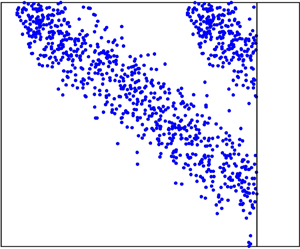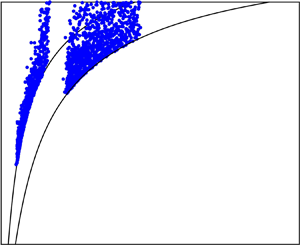We consider the injection of a buoyant low viscosity fluid into an aquifer saturated with a higher viscosity fluid. The nose region of the flow, where the thickness of the injected fluid is less than the thickness of the aquifer, grows in proportion to time and as a result fluid continually migrates further into the nose where it has a progressively smaller vertical extent. We explore how the flow in the nose influences the migration of a pulse of tracer. The growth of the nose stretches a pulse of tracer of initial length,  $L_0$, longitudinally to have a length proportional to
$L_0$, longitudinally to have a length proportional to  $L_0 (T/T_E)^{1/2}$, where
$L_0 (T/T_E)^{1/2}$, where  $T_E$ is the nose entry time. Diffusion acts at the same rate and the combination of the two processes results in an tracer spreading longitudinally with a length proportional to
$T_E$ is the nose entry time. Diffusion acts at the same rate and the combination of the two processes results in an tracer spreading longitudinally with a length proportional to  $(D T\, \log T)^{1/2}$ at long times after entering the nose, where D is the coefficient of diffusion. The results are generalised to consider the case in which the permeability in the aquifer varies with depth. At early times, the tracer is sheared. As the tracer migrates into continually thinner regions of the growing nose, the permeability contrast sampled by the tracer rapidly decays. The role of the shear becomes dominated by the stretching of the nose and ultimately the late-time behaviour is as in a uniform aquifer. However, the effective pulse length of the tracer upon asymptoting to the stretching regime is now given by
$(D T\, \log T)^{1/2}$ at long times after entering the nose, where D is the coefficient of diffusion. The results are generalised to consider the case in which the permeability in the aquifer varies with depth. At early times, the tracer is sheared. As the tracer migrates into continually thinner regions of the growing nose, the permeability contrast sampled by the tracer rapidly decays. The role of the shear becomes dominated by the stretching of the nose and ultimately the late-time behaviour is as in a uniform aquifer. However, the effective pulse length of the tracer upon asymptoting to the stretching regime is now given by  $L_0={\rm \Delta} U T_E$, where
$L_0={\rm \Delta} U T_E$, where  ${\rm \Delta} U$ is the magnitude of the shear. The spreading in the stretching regime then has a length scale of
${\rm \Delta} U$ is the magnitude of the shear. The spreading in the stretching regime then has a length scale of  ${\rm \Delta} U (T_E T)^{1/2}$, which may be much faster than in the case of a uniform aquifer. If the diffusion is sufficiently fast, there may be an intermediate regime in which Taylor dispersion is important prior to the stretching dominating.
${\rm \Delta} U (T_E T)^{1/2}$, which may be much faster than in the case of a uniform aquifer. If the diffusion is sufficiently fast, there may be an intermediate regime in which Taylor dispersion is important prior to the stretching dominating.












